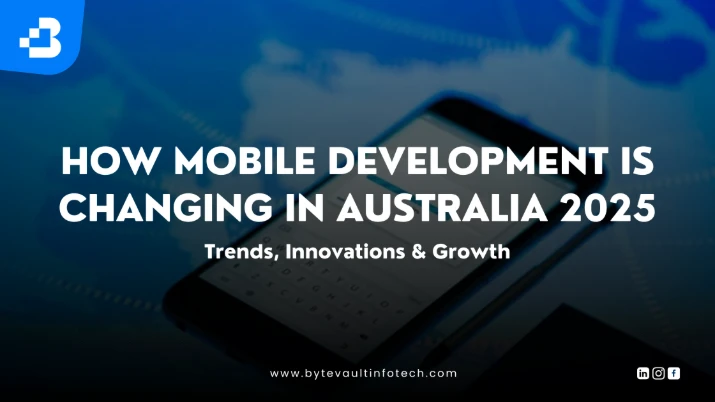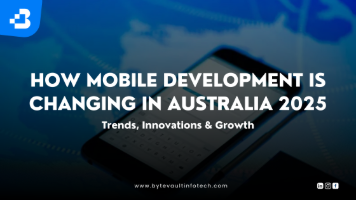
From Brisbane to Perth, Sydney to Melbourne, the mobile development scene is buzzing with innovation that’s reshaping how businesses interact with consumers and how everyday Australians use their devices.
The Current State of Mobile Development in Australia
The Australian mobile development industry has matured significantly by 2025, becoming one of the country’s most dynamic tech sectors. With over 15,000 professional mobile developers working across various industries, the market continues to expand at an impressive rate.
Key Market Statistics and Growth Projections
The mobile app market in Australia is now valued at approximately AUD 7.8 billion, representing a 34% increase from 2022 figures. Business investment in mobile solutions has doubled since 2021, with enterprises allocating an average of 28% of their IT budgets to mobile development and maintenance.
According to the Australian Mobile Development Association (AMDA), the industry is projected to grow by another 23% by 2027, creating an estimated 5,000 new jobs in the process. This growth is primarily driven by increased demand for specialized applications in healthcare, finance, education, and retail sectors.
Leading Mobile Development Hubs Across Australia
While Sydney and Melbourne have traditionally dominated the mobile development landscape, 2025 has seen significant growth in regional hubs:
- Sydney: remains the largest center with approximately 42% of the country’s mobile development workforce, particularly strong in fintech and enterprise applications.
- Melbourne: focuses heavily on creative and design-led mobile experiences, hosting 28% of developers.
- Brisbane: has emerged as Australia’s fastest-growing mobile development hub, with a 47% increase in developer population since 2022, largely due to government incentives and lower overhead costs.
- Perth: has developed a specialized niche in mining, resources, and remote operations mobile solutions.
- Adelaide: has become a center for health-tech mobile applications, benefiting from local university research partnerships.
The geographic distribution of talent has been aided by widespread remote work adoption, allowing developers to contribute to projects regardless of their location, a trend that gained momentum during the early 2020s and has now become standard practice.
Technological Innovations Reshaping Mobile Development
The technological landscape underpinning mobile development in Australia has evolved dramatically in 2025, bringing both challenges and opportunities for developers.
5G and 6G Network Implementation
Australia’s 5G network now covers 97% of the populated areas, with early 6G testing underway in major cities. This expanded bandwidth has revolutionized what’s possible in mobile applications:
- Real-time data processing capabilities have increased by factor of 10
- Latency has decreased to almost imperceptible levels (under 1ms in optimal conditions)
- Mobile streaming quality has improved to consistent 8K resolution
- IoT device connectivity has expanded exponentially, with the average Australian household managing 27 connected devices through mobile applications
Developers are capitalizing on these advancements by creating more data-intensive applications with seamless cloud integration. The reduced latency has particularly benefited mobile gaming and augmented reality applications, allowing for experiences previously only possible on high-end computers.
Rise of Cross-Platform Development Frameworks
By 2025, cross-platform development has become the dominant approach for Australian developers, with native-only development declining to just 23% of new projects.
Flutter vs React Native: Australian Developers’ Preferences
The landscape has shifted considerably:
- Flutter has captured 43% of cross-platform development projects in Australia, appreciated for its performance and consistent UI across platforms
- React Native follows at 37%, still favored for web-to-mobile transitions
- New entrants like Kotlin Multiplatform Mobile (KMM) have gained 12% market share
- Other solutions comprise the remaining 8%
The economics simply make sense,” explains Sunil Patel, CTO at Sydney-based AppFuture. “With skilled developers commanding salaries upwards of AUD 160,000, businesses are looking for efficiency. Cross-platform development delivers 80–90% code reusability while maintaining near-native performance in most cases.
AI Integration in Mobile Applications
Perhaps no technological advancement has impacted mobile development more profoundly than artificial intelligence. In 2025, AI has transcended from a novelty feature to an essential component of mobile applications across Australia.
Machine Learning Models for Personalized User Experiences
The integration of on-device machine learning models has become standard practice, with 78% of top-grossing Australian apps implementing some form of AI-driven personalization. These applications analyze user behavior patterns to customize interfaces, content, and functionality without requiring constant cloud connectivity.
Retail applications lead the way in this trend, with virtual shopping assistants that can predict purchasing intentions and make recommendations based on visual recognition of user preferences. Banking apps now routinely implement AI for fraud detection and personalized financial advice, while health and fitness applications use machine learning to create custom workout and nutrition plans.
AI-Driven Development Tools and Their Impact
The development process itself has been transformed by AI. Australian developers increasingly employ:
- AI code assistants that can generate up to 40% of routine code
- Automated testing tools that simulate thousands of user scenarios
- Design-to-code systems that translate mockups directly into functional interfaces
- Voice and natural language processing libraries that enable more intuitive user interactions
This automation has shifted the role of developers toward more strategic thinking and complex problem-solving, while routine coding tasks are increasingly handled by AI assistants.
Sustainability in Mobile Development
Environmental consciousness has become a defining characteristic of Australian mobile development in 2025, reflecting broader societal concerns about climate change and resource consumption.
Green Coding Practices
“Green coding” has moved from a fringe concept to mainstream practice. Australian developers are increasingly evaluated on the efficiency of their code, not just its functionality. This involves:
- Optimizing algorithms to reduce processing requirements
- Minimizing network calls to reduce energy consumption
- Employing efficient data storage practices
- Using dark mode by default to reduce screen energy usage on OLED displays
The Australian government has introduced incentives for businesses that adopt these practices, including tax benefits for certified “green applications” that meet strict efficiency standards.
Energy-Efficient Applications
Beyond the code itself, Australian developers are creating applications specifically designed to help users reduce their environmental impact:
- Smart home applications that optimize energy usage based on real-time electricity pricing
- Transportation apps that calculate and display the carbon footprint of travel options
- Shopping applications that provide sustainability ratings for products
- Resource management tools for businesses to track and reduce waste
These applications represent a growing segment of the Australian mobile market, with investments in sustainability-focused startups increasing by 67% since 2023.
The Shift Towards Progressive Web Apps (PWAs)
Progressive Web Apps have seen remarkable adoption across Australia in 2025, particularly for businesses seeking to maintain presence across multiple platforms without the overhead of multiple codebases.
PWAs now account for approximately 31% of new mobile projects in Australia, offering several advantages:
- Reduced development and maintenance costs compared to native applications
- Elimination of app store approval processes and associated fees
- Improved discoverability through search engines
- Faster updates and deployment cycles
The retail sector has been particularly quick to adopt PWAs, with major Australian retailers reporting 22–38% increases in mobile conversions after transitioning from native apps to progressive web applications.
“For many businesses, particularly those with straightforward functionality requirements, PWAs represent the sweet spot between capability and cost,” notes Emma Chen, Digital Transformation Lead at Deloitte Australia. “We’re seeing clients achieve 70% of the benefits of native apps at roughly 40% of the development and maintenance cost.”
Augmented Reality and Virtual Reality in Mobile Apps
AR and VR technologies have matured significantly in the Australian mobile development landscape by 2025. What was once considered experimental has become practical and profitable across multiple sectors.
Industry-Specific AR/VR Applications
Several industries are leading AR/VR adoption in mobile applications:
- Real Estate: Virtual property tours have become standard, with 73% of Australian real estate listings now offering AR/VR experiences through mobile apps
- Retail: Virtual try-on experiences for clothing, accessories, and cosmetics have reduced return rates by an average of 27% for implementing businesses
- Education: AR-enhanced learning applications have demonstrated 32% better information retention in studies conducted by Australian universities
- Tourism: Location-based AR experiences that overlay historical or cultural information have revitalized tourism in post-pandemic Australia
The hardware limitations that previously hindered mobile AR/VR experiences have largely been overcome through cloud-rendering solutions that offload processing demands to edge computing networks, allowing even mid-range devices to deliver compelling experiences.
Cybersecurity Trends in Australian Mobile Development
With increased functionality comes increased responsibility. Australian mobile developers in 2025 face stringent security requirements, both regulatory and market-driven.
Privacy-First Development Approaches
Following the introduction of the Australian Privacy Act amendments in late 2023, mobile applications must now implement “privacy by design” principles from the ground up. This includes:
- Mandatory data minimization (collecting only essential user information)
- Clear consent mechanisms for all data collection
- Local data processing wherever possible
- Enhanced encryption for all stored and transmitted data
- Regular security audits and vulnerability assessments
These requirements have spawned a new specialization within the industry: privacy engineers who work alongside developers to ensure compliance while maintaining functionality.
The financial consequences of security breaches have also increased dramatically, with fines of up to 10% of Australian revenue for serious violations. This has elevated cybersecurity from an afterthought to a primary concern throughout the development lifecycle.
The Future of Mobile Development Careers in Australia
The career landscape for mobile developers has evolved significantly by 2025. The traditional role of the “mobile developer” has splintered into multiple specialized paths:
- Mobile Security Specialists command the highest salaries, averaging AUD 185,000
- AI Integration Engineers focus specifically on implementing and training machine learning models for mobile contexts
- Cross-Platform Architects design applications that function seamlessly across different operating systems and form factors
- Mobile UX Specialists concentrate on creating intuitive and accessible interfaces
- Mobile DevOps Engineers manage the increasingly complex deployment and monitoring systems
Education has adapted to these changes, with Australian universities offering specialized mobile development tracks that include both technical skills and the business acumen needed to align development with strategic objectives.
“The days of the generalist mobile developer are waning,” observes Professor Rajiv Menon of RMIT’s Digital Futures Department. “We’re training students not just in coding, but in specialized skills that reflect the fragmentation and maturation of the industry.”
FAQs: Mobile Development in Australia 2025
Q1. How does remote work affect Australian mobile development?
Remote work has decentralized talent, enabling hybrid teams across cities like Sydney and Melbourne. This reduces office costs and diversifies skillsets, with developers collaborating virtually while maintaining strategic in-person meetings.
Q2. What programming languages dominate Australian mobile dev in 2025?
Top languages: Dart (Flutter) for cross-platform apps, Swift/Kotlin for native iOS/Android, and Python for AI integration. JavaScript/TypeScript remain key for React Native and PWAs.
Q3. How do Australian developers improve app accessibility?
Developers prioritize voice navigation, screen reader compatibility, and WCAG compliance. Many firms hire accessibility specialists to ensure apps meet legal standards and inclusive design best practices.
Q4. How has app store economics changed in Australia?
PWAs and direct downloads now rival app stores due to lower commissions (10–15%) from regulatory changes. Businesses increasingly bypass traditional platforms to reduce costs.
Q5. How are schools preparing students for mobile dev careers?
Australian universities offer dedicated mobile dev degrees with AI, security, and cross-platform specializations. Students gain real-world experience via industry projects in Brisbane, Perth, and Melbourne.
Conclusion
The mobile development landscape in Australia has undergone remarkable transformation by 2025. From the integration of AI and machine learning to the adoption of sustainable practices, from cross-platform dominance to specialized career paths, the industry bears little resemblance to its state just five years ago.
As Australia continues to position itself as a technology leader in the Asia-Pacific region, mobile development remains at the forefront of digital innovation. The successful mobile developers and businesses will be those who embrace these changes, continuously updating their skills and approaches to match evolving technologies and user expectations.
For businesses, the message is clear: mobile experiences are no longer optional but essential components of customer engagement strategies. For developers, the industry offers unprecedented opportunities for those willing to specialize and adapt to this rapidly changing landscape.
The future of mobile development in Australia looks promising, complex, and full of potential for those prepared to navigate its challenges. If you're considering building a mobile solution for your business, explore our comprehensive mobile app development services tailored for Australian businesses.


